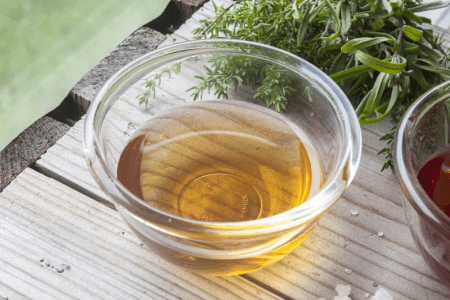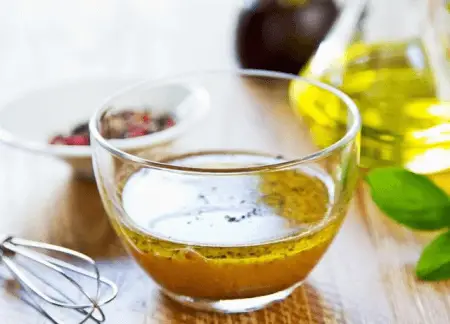Vinegar is a staple in almost every household. Aside from adding flavor to your food, it also has several other uses. However, we also come across the term “vinaigrette” in cooking shows, cook books and websites, which leads us to wonder, “Are they the same?” This article will discuss the difference between vinegar and vinaigrette.
Summary Table
| Vinegar | Vinaigrette |
| Contains acetic acid, water and flavorings | A mixture of vinegar (or lemon juice), oil, herbs and spices |
| Made by fast or slow fermentation | Made by whisking vinegar and oil then adding in herbs and spices |
| Used as an ingredient in cooking, making sauces, pickling fruits and vegetables, or making vinaigrettes | Used as a salad dressing or meat marinade before cooking |
| Can be used to clean, disinfect, as an herbicide, and also has medicinal properties | Because it is a mixture of vinegar, oil and other ingredients, it cannot be used for cleaning and disinfecting |
Definitions

Vinegar is a liquid matter usually composed of water, some flavorings, and acetic acid which is produced by fermentation. It is made from fermenting alcohol, such as malt, wine, or cider, , creates a sour-tasing liquid that has a pH of 2-3. Commercial vinegar is produced by a fast fermentation process and is made in less than 24 hours. Traditional vinegar is made by slow fermentation that can last for months up to a year.
Vinegar comes in many different varieties; each one has its own special flavor and acidity level. You can try white vinegar, apple cider vinegar, balsamic vinegar, red wine vinegar, and rice vinegar, among others.
Vinegar is used as a condiment and as an ingredient in cooking, making sauces, pickling fruits and vegetables, and making vinaigrettes and other salad dressings. Aside from being a staple in the kitchen, it is also known as an environment-friendly cleaning agent and disinfectant, and is even used in households to clear clogs, polish silver and brass, remove wallpaper and clean dirty mirrors and windows. It is also believed to have a medicinal purpose and is used as an herbicide. It has several varieties like cane, apple cider, coconut, balsamic, white and wine vinegar.

On the other hand, a vinaigrette is a combination of oil, salt, herbs, spices and vinegar. “Vinaigrette” is a French word that comes from the root word “vinaigre,” which means vinegar. “Ette” means something small. Why the word “small?” This is a reference to the amount of vinegar used in a vinaigrette. A small amount of vinegar is used along with other ingredients. The ratio of vinegar to oil can vary, depending on the type of vinaigrette you make.
Other ingredients in a vinaigrette can include egg yolks, mustard, fruit, vegetable purees, and more.
Depending on your preference, olive oil, soybean oil, or even sunflower oil can be used. For the vinegar, balsamic vinegar and apple cider vinegar are most commonly used in vinaigrettes. Some people use lemon juice instead of vinegar. Other ingredients like garlic, chili peppers, onions, tomatoes, nuts and maple syrup can also be added depending on your taste.
Usually, 3 parts oil and 1 part vinegar are combined and whisked until the mixture forms an emulsion. Just like the ingredients, the proportion of the vinegar and oil can be modified depending on your style. Vinaigrette is used as salad dressing and also to marinate meat before cooking.
It can also be used on boiled foods, as a dip, or even brushed on sandwiches. Vinaigrettes don’t require specialized equipment. They’re easy to make with tools such as a whisk (or blender), a food processor, a bowl, or even an electric mixer. A vinaigrette can even be used to brush on bread, creating a tasty snack or side dish.
Here’s a simple vinaigrette you can use with everything from cauliflower, potato salad and more!
Brown Butter Vinaigrette Recipe
- ¼ cup salted butter
- ¼ cup avocado oil
- 1 tablespoon maple syrup
- 1 tablespoon balsamic vinegar
- 1 tablespoon apple cider vinegar
- ½ tablespoon Dijon mustard
Instructions
- In a small frying pan over high heat, melt butter. Stir it continuously until it browns (about 1-2 minutes). Once the butter is evenly browned, remove the small frying pan from the heat. Add in the avocado oil and set aside to allow the butter to cool a bit.
- In a medium bowl, whisk together the maple syrup, balsamic vinegar, apple cider vinegar, and Dijon mustard. Slowly drizzle the browned butter and oil into the mix, whisking at the same time. When everything has been added, whisk the sauce for a few seconds, until it becomes emulsified (creamy).
- Store the sauce at room temperature until you’re ready to use it. Enjoy!
Vinegar vs Vinaigrette
What, then, is the difference between vinegar and vinaigrette?
Vinegar is a combination of water, acetic acid and some flavorings, while vinaigrette is a combination of vinegar (or lemon juice), oil, herbs, spices and other ingredients depending on your preference.
Moreover, vinegar is used as a condiment or as an ingredient in cooking: making sauces, vinaigrettes and other salad dressings or processing pickled fruits and vegetables. On the other hand, vinaigrette is used as a salad dressing and sometimes as a marinade.
Due to its acetic acid content, vinegar is also used as a cleaning and disinfectant agent. It also used as a herbicide and is believed to have a medicinal purpose. On the contrary, although vinaigrette contains vinegar that has cleaning properties, it is not used for disinfecting and cleaning because it contains oil, herbs and spices as well as vinegar.





